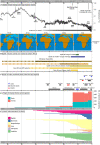Tectonics, climate and the diversification of the tropical African terrestrial flora and fauna
- PMID: 32924323
- PMCID: PMC7821006
- DOI: 10.1111/brv.12644
Tectonics, climate and the diversification of the tropical African terrestrial flora and fauna
Abstract
Tropical Africa is home to an astonishing biodiversity occurring in a variety of ecosystems. Past climatic change and geological events have impacted the evolution and diversification of this biodiversity. During the last two decades, around 90 dated molecular phylogenies of different clades across animals and plants have been published leading to an increased understanding of the diversification and speciation processes generating tropical African biodiversity. In parallel, extended geological and palaeoclimatic records together with detailed numerical simulations have refined our understanding of past geological and climatic changes in Africa. To date, these important advances have not been reviewed within a common framework. Here, we critically review and synthesize African climate, tectonics and terrestrial biodiversity evolution throughout the Cenozoic to the mid-Pleistocene, drawing on recent advances in Earth and life sciences. We first review six major geo-climatic periods defining tropical African biodiversity diversification by synthesizing 89 dated molecular phylogeny studies. Two major geo-climatic factors impacting the diversification of the sub-Saharan biota are highlighted. First, Africa underwent numerous climatic fluctuations at ancient and more recent timescales, with tectonic, greenhouse gas, and orbital forcing stimulating diversification. Second, increased aridification since the Late Eocene led to important extinction events, but also provided unique diversification opportunities shaping the current tropical African biodiversity landscape. We then review diversification studies of tropical terrestrial animal and plant clades and discuss three major models of speciation: (i) geographic speciation via vicariance (allopatry); (ii) ecological speciation impacted by climate and geological changes, and (iii) genomic speciation via genome duplication. Geographic speciation has been the most widely documented to date and is a common speciation model across tropical Africa. We conclude with four important challenges faced by tropical African biodiversity research: (i) to increase knowledge by gathering basic and fundamental biodiversity information; (ii) to improve modelling of African geophysical evolution throughout the Cenozoic via better constraints and downscaling approaches; (iii) to increase the precision of phylogenetic reconstruction and molecular dating of tropical African clades by using next generation sequencing approaches together with better fossil calibrations; (iv) finally, as done here, to integrate data better from Earth and life sciences by focusing on the interdisciplinary study of the evolution of tropical African biodiversity in a wider geodiversity context.
Keywords: African geology; Cenozoic; dated molecular phylogenies; fossils; palaeoclimate models; speciation models; tropical Africa.
© 2020 The Authors. Biological Reviews published by John Wiley & Sons Ltd on behalf of Cambridge Philosophical Society.
Figures




References
-
- Andrews, P. & Van Couvering, J. A. (1975). Palaeoenvironments in the east African Miocene In Appraoches to primate paleobiology (ed. Szalay F.), pp. 62–103. Karger, Basel. - PubMed
-
- Anthony, N. M. , Johnson‐Bawe, M. , Jeffery, K. , Clifford, S. L. , Abernethy, K. A. , Tutin, C. E. , Lahm, S. A. , White, L. J. T. , Utley, J. F. , Wickings, E. J. & Bruford, M. W. (2007). The role of Pleistocene refugia and rivers in shaping gorilla genetic diversity in Central Africa. Proceedings of the National Academy of Sciences of the United States of America 104, 20432–20436. - PMC - PubMed
-
- Anthony, F. , Diniz, L. E. C. , Combes, M.‐C. & Lashermes, P. (2010). Adaptive radiation in Coffea subgenus Coffea L. (Rubiaceae) in Africa and Madagascar. Plant Systematics and Evolution 285, 51–64.
-
- Antonelli, A. , Ariza, M. , Albert, J. , Andermann, T. , Azevedo, J. , Bacon, C. , Faurby, S. , Guedes, T. , Hoorn, C. , Lohmann, L. G. , Matos‐Maraví, P. , Ritter, C. D. , Sanmartín, I. , Silvestro, D. , Tejedor, M. , ter Steege, H. , Tuomisto, H. , Werneck, F. P. , Zizka, A. & Edwards, S. V. (2018a). Conceptual and empirical advances in Neotropical biodiversity research. PeerJ 6, e5644 10.7717/peerj.5644. - DOI - PMC - PubMed
Publication types
MeSH terms
Grants and funding
LinkOut - more resources
Full Text Sources
Miscellaneous

